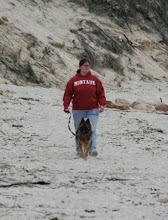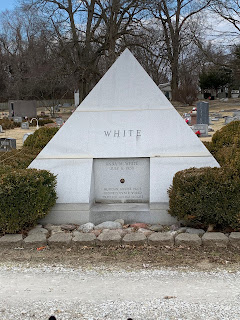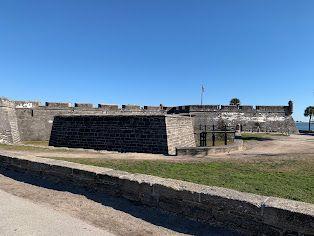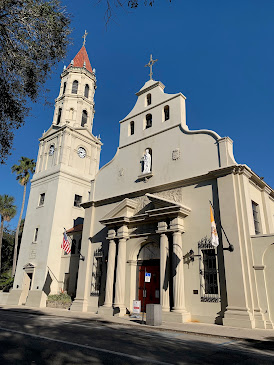With each paranormal investigation we try and do at least some historical research to understand the location and area. So once I bought two tickets to a public investigation at Harriman Hospital in Harriman, TN we began researching not just the building but the whole area.
Harriman is located in Roane County in East Tennessee.
TN became a state on June 1st, 1796 and five years later in 1801 Roane County was formed. The area's main geographical features are the meeting of the Tennessee, Clinch, and Emory Rivers into Watts Bar Lake and it sits on the boundary between the Tennessee Valley and the Cumberland Plateau.
The American Civil War has been characterized as neighbor versus neighbor and that was keenly felt in East Tennessee. On June 7th, 1861 future President Andrew Johnson spoke against secession on the steps of the Roane County Courthouse in Kingston, TN. The next day the county voted on the manner and voted 1,568 to 454 in favor of remaining in the Union. Unfortunately the statewide vote finished at 102,172 - 47,328 in favor of secession. East Tennessee was out-voted and the state joined the Confederacy. On a side note if you ever get the chance to visit the Civil War Battlefield in Vicksburg there is a fantastic statue representing Kentucky click here for my blog from that trip.
Robert King Byrd was a local farmer, experienced military man, pioneer, trader, and political figure. He was the son of Joseph Byrd who had served as Roane County Sheriff and had assisted in the 1836 forced removal of the Cherokee Nation from the area. Robert was against secession because he believed the Union should stand. However he also owned slaves but when faced with a choice between the two he would rather preserve the Union. Of his eight brothers four would serve in the Union army while two joined the Confederacy. Byrd had made a name for himself during the Mexican War and faced with a threat to the Union he founded the 1st Tennessee Infantry and lead almost 2,000 men for the Union from 1861-1864, which included the majority of the adult male population of Roane County. His troops and leadership played major roles in several battles including Mills Springs, Cumberland Gap, Sander's Raid on Knoxville, Stone River, and the Battle of Atlanta. Under Sherman in Atlanta his troops were the first to cross the Chattahoochee six miles upstream of Pace's Ferry. At Cumberland Gap he was shot in the left side below his heart but returned to his command four weeks later. At Stone River his horse was shot from under him and his clothes had bullet holes but he was unharmed and commended on his bravery by two generals.
In 1864 he returned home to Roane County and his wife Mary. During the war she had also left home after a warrant for her arrest was issued by the Confederates as a "dangerous enemy of the South." Oliver Perry Temple, an attorney and organizer of East Tennessee Unionist as well as co-founder of Rugby TN, described Mary by saying "[n]o one could look into her piercing eyes without recognizing that there was within her frail form an unconquerable will and a dauntless spirit." Robert would live in the area and spend his days trying to preserve and repair the damage done to the Union until his death in 1885. Due, in part, to his work Tennessee was the first Confederate State to rejoin the Union on July 24th, 1866. In his own words "I went into war to save my country from the foolishness of my friends... We saved the country. Now, in the name of God, let us preserve our liberty."
The Byrd property was split by the Emory River. On one side was Robert and Mary's home. On the south side was their coal mine which was said to be the best coal in the Cumberland Plateau. Not only was the land rich with coal but it also was full of limestone. In 1889, four years after Robert passed away, Captain J.W. Ayers representing the East Tennessee Land Company purchased the property from Mary. She would stay in the area and passed away in 1902. Mary is buried in Bethel Cemetery in Kingston, Tennessee and was mentioned in the "Statement of Significance" section on the cemetery's application to be listed on the National Register Of Historical Places.
The goal of the East Tennessee Land Company, directed by Walter Harriman, was to build a planned city grounded in the Temperance Movement, a social movement against the consumption of alcoholic beverages. The other primary founders of the town were Minister Frederick Gates, Isaac Funk, AW Wagnalls, Clinton Fisk, and Ferdinand Schumacker. Gates thought the ideals of Temperance would guide the residents and businesses into prosperity. They planned the layout of the town putting the industrial area along the river for easy transport and continuing out with residential, business, and downtown areas. Walter Harriman was from the North East as were most of the founders but the location was selected due to Harriman's father. He had marched through East Tennessee during the Civil War and returned to tell his son about a spot along the Emory River that seemed perfect for a settlement.

In February of 1890 from the porch of the Byrd home a land sale was held for the 10,000 acres that would become Harriman. Over 3,000 men from 18 states came to the auction J. C Woodward of Lexington, Kentucky, was the first purchaser securing his plat at $70 a front foot. On the third day of the sale John C. Snow of Brockton, Massachusetts, purchased land for $275 a front foot and within thirty minutes was offered $300 a foot but declined. By the end of the land sale 573 lots had been purchased for $604,705. Every resident and business that purchased land or operated a business signed an agreement that they would not partake, serve, or sell alcohol. Harriman would be called "The Town That Temperance Built."

The downtown area was planned as the heart of the city. At the corner of Cumberland and Devonia street a private company planned to build a state of the art hotel. Architect Rudolph Gill was commissioned to design the property. When the private company fell into bankruptcy the East Tennessee Land Company took over the property and building of the hotel. The hotel could accommodate up to 150 people and featured steam heat and "the best table in the entire region."
The first two years of Harriman saw a growing thriving city with 4,000 residents and numerous industries. In a booklet published to commemorate the town's two year anniversary a poem entitled "Our Harriman" showed off the town's pride:
Our Harriman
Lift up your voice in glad acclaim,
O ye who gather here to-day.
And echo every heart the name
To which we loving tribute pay.
O Harriman, dear Harriman!
May peace be thine, forever thine!
Brave hearts, and true, in love thy ways defend,
While heaven's blessings on thy homes descend.
Here field and forest waited long
The music of the hammer's ring,
The thrill of Labor's cheerful song.
And bounty that the years might bring.
O Harriman, dear Harriman!
Thy mountain look with pride on thee;
Hope, faith and courage here have builded well,
Long may their faith and works thy people tell!
Here loyal hearts and willing hands
Have lifted high their banners brave,
And heeding Love's divine commands
Have sought the tempted soul to save.
O Harriman, young Harriman,
Grow strong and bold through all the years,
As if within thy pulses run
The blood of thine own pioneers.
O Harriman, our Harriman!
The skies above in blessings bend;
Heav'n hear thy prayer for thee that each heart lifts,
And fill thy future with its choicest gifts.
However in November of 1893 the East Tennessee Land Company declared bankruptcy. Many returned to their home states but others choose to stay and make Harriman their home. In 1918 Harriman faced one of many challenges that would visit the town over the next century. The Influenza Outbreak of 1918 effected Tennessee very severely. One town in neighboring Morgan County, Coalfield, saw 98% of residents infected with the disease. In Harriman the city's two funeral homes did not have the ability to keep up with calls and issued a printed apology to the residents.
I do not know the local numbers but in total in Tennessee alone 7,721 lost their lives due to the fast spreading illness.
In 1921 the Cumberland Hotel was destroyed by fire, the first of several fires that would plague the town.
Then on March 23, 1929, Harriman faced its greatest natural disaster. After a particularly rainy February a strong storm traveling from the Gulf northeast dropped nine inches of rain in the span of 24 hours. At noon on 3/22 the Emory river was 35 feet below its top bank. As the rain fell it began to rise reaching a rate of nine feet per hour. Harriman's idyllic spot in the bend of the Emory helped with transportation for industry. It also set it up for disaster when the water ran over its banks. As quickly as the flood waters came they then receded and by 10:30 pm on the 23 the Emory was within its bank. The rushing waters made recovery difficult and of the 20 lives lost only 10 bodies were found. In total fifty homes were washed away and over 3.5 million dollars of damage was left behind. However beyond the physical damage of the flood waters was the emotional damage and toll it took on the residents. Every resident of Harriman.




One of the worst stories of the flood was the story of Boy Scout Troop 45 that lost seven members and their Scout leader during the flood.

James Tarwater Wright had been trying to bring the troop out for a camping trip but the rainy month had postponed most his plans. When the day came for the planned camping trip to a cabin near Whites Creek he did not want to cancel. After a day of activities Dick Gilbreath brought two of the boys home. The rest and their troop leader set up for the night. Whites Creek is normally 70 feet wide. As the water rose it spread to 600 feet and the cabin was surrounded. James had the boys climb to the roof for safety. The boys who survived noted how their Scoutmaster joked and kept them calm. At first it seemed they would be able to wait out the storm on the roof. However a railroad bridge among several others upstream had been knocked loose and along with other debris began being carried by the current. The cabin was hit and broke into pieces. Some of the boys were able to grab branches and climb into trees for safety but others were thrown from the roof. James Tarwater Wright dove in after his boys and despite being a strong swimmer he was killed by the flood waters. There are some accounts of people being pulled to safety by him however he was not able to find any of the boys who had been thrown off the cabin. In total seven of the boys were killed that night.

Tom Douglas was the youngest member of the Troop and in 1978 gave an account of the night and following day. He described James keeping the boys calm and then diving in after the cabin had been broken. He also told how his brother, Willie, and another boy pulled him from the water and his brother moved him from tree to tree to keep him safe. Willie pulled others from the water and would eventually be awarded a gold medal form the Boy Scouts of America for his actions during the flood. The story of the Scouts made newspapers across the State and when visiting Harriman at any mention of the flood of 1929 it will not take long for someone to add "that is the flood with the Boy Scout Troop."
A monument was erected by local Boy Scout Troops from Harriman and Rockwood in honor of the lost boys and James Wright.
Today along the Emory River is a small water front park called David Webb River Front Park. In the park there is a bench in honor of another hero from the flood. Robert Underwood woke up to flooding near and around his home. He quickly loaded his family into a coal cart and moved them to safety. No one would have given it a second thought if he had remained with his family during that day. But he did not. Instead he returned to the rising waters with his cart and began helping others to safety. Eventually he was in the process of rescuing the Jenkins family when his cart overturned. One child, Felix Jenkins, would survive the accident however Robert and the rest of the family were killed. According to the information on the bench he is credited with saving the lives of 75 families.

Since its founding it is not just flooding which the people of Harriman have had to contend with. Fire has also struck several times. Not only was the Cumberland destroyed by fire in 1921 but the business district has been damaged multiple times. The art deco Princess Theater opened in 1926 and in 1932 it was damaged by fire from a faulty projector and then on January 25, 1939, the theater was destroyed by a fire that started in an adjacent building.
The theater was rebuilt and still stands today showing films as well as hosting live productions.
In 1938 one of the local schools was damaged by fire and had to be rebuilt. Then on January 31st, 1945, during a band recital the elementary school caught fire. The band played as long as they could before evacuating with the crowd. Besides that fire there were two other fires in town that day. A year later a temporary school was struck by fire, in 1969 another fire claimed a school in Harriman, and in March of 1969 the Baptist St. Andrews Church was damaged and had to be razed when a fire started during the service.
Destruction by fire and flood was so frequent then that during a review of the year in the Harriman Record the columnist wrote an article remarking how there had been no disaster during the previous year.
However it should be noted that was January of 1939 looking back at 1938. So as mentioned above on January 25th, 1939, there would be a fire causing over $125,000 worth of damage to the business district followed on February 3, 1939, by a flood.
On December 22, 2008, a containment pond at the nearby TVA Fossil Fuel Plant failed and 5.4 million cubic yards of coal ash was released into the Swan Pond Embayment, a recreational area used by many Harriman residents. While dredging the coal ash workers discovered barrels that had been dumped in the preceding decades from the nearby Oakridge nuclear facility. Many of the clean up workers were not aware of the full extent of hazardous chemicals in the coal ash and would eventually become ill and be forced to file a lawsuit against Jacobs Engineering. In 2018 the company was found guilty of endangering the health of the workers and their families and began paying for medical expenses.
After the Cumberland Hotel burnt down in 1921 it was replaced by a roller rink before finally being replaced by The Old Harriman Hospital (Roane County Medical Center). Throughout its time it was added on to multiple times including the addition of more surgical rooms, extended ICU, geriatric wing, psych ward, and a state of the art surgical ward.
Around 2013 the hospital was closed when a new facility opened nearby. The Harriman Industrial Board took possession of the building and thought about bulldozing it to increase downtown parking. Thankfully they did not when they discovered it would cost almost 1 million to take it down. Instead Ronnie Dee, owner of Old South Pittsburg Hospital saw the potential in the building and the rich history.
June 11th, 2022, was the Old Historic Harriman Hospital Opening night as it was opened up to Paranormal Investigators to discover the stories of the spirits who lived, died, or worked there throughout its many years.
Part 2: The Investigation

























































